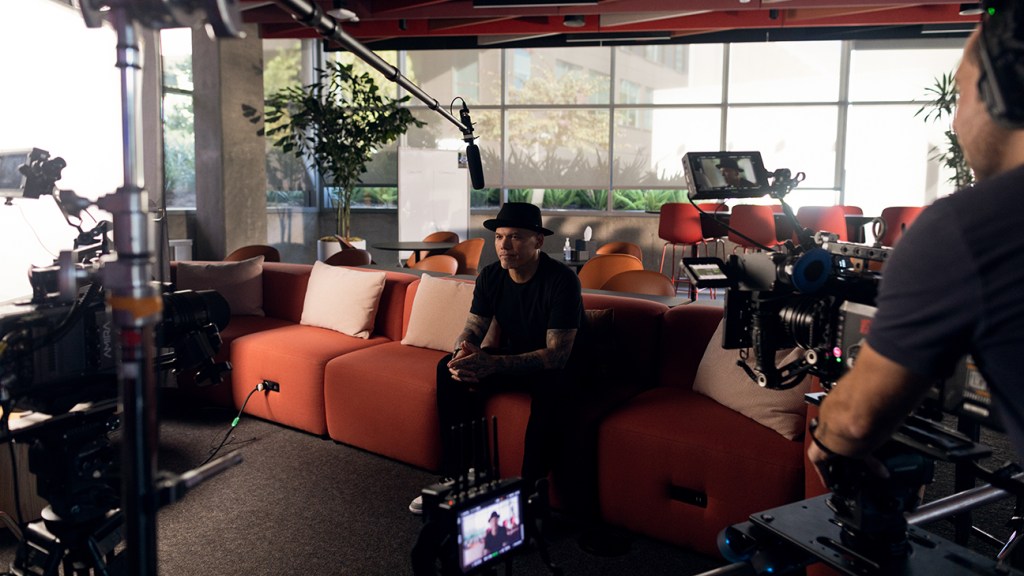
Andy Lerma during filming of Making Space and Netflix graphic design tutorial
Courtesy of Making Space
Netflix and Making Space have teamed on a new tutorial program to expand education and career access for current and aspiring graphic designers with disabilities interested in pursuing roles in the film and entertainment industry.
The streamer, alongside the talent acquisition and learning experience platform co-founded by Sophie Morgan and Keely Cat-Wells, co-developed the five-course tutorial centered on key art and poster design. Disabled artists, including those who are blind or low vision, chronically ill, Deaf or hard of hearing, and neurodivergent, will be taught essential elements in design such as concept, style and lighting, composition, typography, and color and mood.
“As someone who has navigated my career with dyslexia and [an] auditory processing disorder, I know how challenging it can be for disabled artists to break into the industry,” said Netflix Design Lead Andy Lerma. “Netflix has always empowered me to do my best work, and it’s an honor to partner with Making Space to help aspiring designers pursue their dreams.”
Courses, which adhere to Netflix’s own design standards and were produced by a disabled and women-led team from Intuition Films and Making Space Media, explore subjects like the evolution of art in film. They will also incorporate accessibility features like American Sign Language, captions, speed control and customizable text display.
The programming, which interested artists can apply for on Making Space’s website, will equip a diverse range of disabled talent with in-demand skills applicable to film and entertainment work to successfully pursue a career in graphic design.
The tutorial is open to “everyone and anyone, no matter what their experience,” says Wells. But it is primarily aimed at people serious about a career in graphic design who have some experience, as the program’s goal is to consider selected artists, upon successful completion of the course and assignment, for temporary contract opportunities at Netflix. Previous experience can range from sketch art and fan art to graphic design and fine art.

Keely Cat Wells (right) during the filming of Netflix and Making Space’s graphic design tutorial.
A combination of barriers currently exist for all artists looking to break into the industry, such as institutional biases and financial and regional accessibility. But Wells notes those can be compounded with access issues specific to talent with disabilities.
“This Making Space and Netflix partnership is creating new accessible pathways into entertainment for disabled artists based on talent and merit,” she tells The Hollywood Reporter. “Historically, barriers like prioritizing stamina over skills, lack of existing connections and location have blocked entry. Our approach focuses on developing relevant industry knowledge, tailoring training directly to Netflix’s design standards and creating tangible pathways to employment.”
For the Making Space CEO, the nature of graphic design work — like its remote capabilities — should make it a career path that is easier to access. With the tutorial, she says, her organization can help realize that by addressing issues around physical and financial inaccessibility, including unpaid internships.
“What this course does, and why we were really excited to partner specifically on creating a talent pipeline for graphic designers, is that it is a great place for us to start bringing down those barriers,” she adds. “We’re creating this pathway where people don’t have to work this unpaid, voluntary role. You’ll be pre-qualified in this pipeline to be considered for real, paid work at one of the biggest studios in Hollywood.”
The graphic design program also tackles an often under-covered element of Hollywood’s representation and inclusion conversation: the technical and creative ways Hollywood markets to (or, more often, doesn’t) disabled consumers. Wells points to the use of Braille in Netflix’s marketing campaign for All the Light We Cannot See as a way the streamer “spoke directly to blind and low-vision audiences.”
Andy Lerma, design lead at Netflix (left) during filming of the design tutorial.
“We often talk about representation in front of the camera, why that’s important for authenticity and to have the story speak to the people it’s really talking about. But we never really touch on things like key art and marketing materials and poster design, though they’re crucial,” the Making Space co-founder says. “Storytelling in our movie and TV marketing affects likely even more people than those who actually watch it because more people are exposed just to the marketing. Whether we realize it or not, we are being impacted by that marketing material, so having disabled people telling stories in the marketing, and in different ways, is just going to bring more ad audiences into the film or show.”
The tutorial course is the latest example of how Making Space is working to create talent pipelines for disabled creatives in entertainment spaces they have been historically marginalized. It follows an unscripted deal with Reese Witherspoon’s Hello Sunshine and more recently with NBC Sports for on and offscreen opportunities tied to the network’s 2024 Paralympic Games coverage.
“Whether that is unscripted, scripted, graphic designers, financial analysts, production accountants — we want to change the way that disabled people break in and bridge that education employment divide that is so prominent, even more with new technologies and the industry changing so rapidly,” explains Wells. “This isn’t just a need for the talent. This is a need for the companies, and we are ensuring that we are tying impact to business strategy. It’s not a one-off initiative that companies can say they’ve done and tick the box.
She adds: “We are passionate about getting disabled people into actual work, and creating careers rather than just jobs.”